|
|
 |
|
Calanoida ( Order ) |
|
|
|
Clausocalanoidea ( Superfamily ) |
|
|
|
Aetideidae ( Family ) |
|
|
|
Pseudochirella ( Genus ) |
|
|
| |
Pseudochirella spectabilis (Sars, 1900) (F,M) | |
| | | | | | | Syn.: | Undeuchaeta spectabilis Sars, 1900 (p.59, figs.F,M); Mrazek, 1902 (p.522); Wilson, 1936 c (p.90); Sewell, 1948 (p.496); Richter, 1994 (tab.4.1a);
Euchirella elongata Wolfenden, 1905 a (p.19, figs.F); 1911 (p.239, figs.F);
Pseudochirella elongata : Vervoort, 1957 (p.69, Rem.); Park, 1978 (p.159, figs.F,M); Markhaseva, 1984 (p.512, figs.F,M); Hopkins & Torres, 1988 (p.82, tab.2); Markhaseva, 1989 (p.39, 41, figs.F,M); Auel & Hagen, 2002 (p.1013, tab.2) | | | | Ref.: | | | Brodsky, 1950 (1967) (p.187, figs.F,M); Vidal, 1971 a (p.15, 25, 118, figs.F,M); Bradford & Jillett, 1980 (p.67); Markhaseva, 1989 (p.38, fig.F); 1996 (p.289, figs.F,M, Rem.); Bradford-Grieve & al., 1999 (p.879, 923, figs.F,M) | 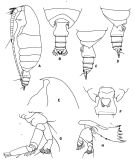 issued from : T. Park in Antarctic Res. Ser. Washington, 1978, 27. [p.160, Fig.37]. As Pseudochirella elongataFemale (from 60°53'S and 67°55'S in the pacific Ocean): A, habitus (left side); B, posterior part of metasome and urosome (dorsal view); C, idem (left side); D, idem (right side); E, forehead (lateral); F, posterior part of metasome and genital segment (ventral view); G, A2; H, Md. Nota : Proportional lengths of prosome and urosome about 79 :21. Single rostrum pointing downward. Frontal eminence inconspicuous, bearing suprafrontal sensilla. Cephalon and 1st thoracic ssegment incompletely fused, 4th and 5th thoracic segments separate. Posterolateral corners of last thoracic segment produced distally into pointed processes, asymmetrical (dorsal view), with right side more produced than left and curved inward. Dorsally, genital segment gradually increasing in width posteriorly, with widest part close to its distal end, and asymmetrical with proyuberance on right side. Laterally, genital swelling located on anterior half of segment. A1 reaching distal end of 2nd urosomal segment. Exopod of A2 nearly twice length of endopod, 7-segmented ; 1st without a seta, 2nd with a minute seta distally. Md : chewing blade powerfully developed. Basis with 3 setae. 1st endopodal segment with 2 setae. Mx1 : with 14 setae on 1st lobe, 5 on the 2nd, and 4 on the 3rd inner lobe ; 5 on the basis, 16 on endopod, 11 on exopod, and 9 on outer lobe. Mx2 with 5 lobes of approximately equal length, each beraing 3 setae. ; first to fourth lobes each also bearing a patch of spinules distally. Distal portion of Mx2 with 6 long setae in addition to 2 small setae. Coxa of Mxp with 3 groups of 3 setae each. Basis longer than coxa by about 2/5 its length, with 3 setae medially and 2 distally. P1 : first 2 exopodal segments partially fused, each with an external spine. P2 : Endopod incompletely 2-segmented. P3 and P4 with usual 3-segmented exopods and endopods. Coxa of P4 with comb of 8-11 strong spines across mediodistal portion of posterior surface.
|
 issued from : T. Park in Antarctic Res. Ser. Washington, 1978, 27. [p.161, Fig.38]. As Pseudochirella elongataFemale: A, Mx1; B, P1; C, P2; D, basipods of P4 (posterior view); P1-2: legs (anterior view). Mx1 with 14 setae on 1st inner , 5 on second, 4 on 3rd lobe; 5 on basis, 16 on endopod, 11 on exopod, and 9 on outer lobe.lobe
|
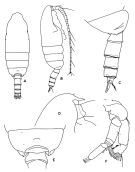 issued from : T. Park in Antarctic Res. Ser. Washington, 1978, 27. [p.162, Fig.39]. As Pseudochirella elongataMale: A, habitus (dorsal view); B, idem (right side); C, posterior part of metasome and urosome (right side); D, forehead (lateral); E, last metasomal and genital segments (dorsal view); F, A2. Nota : Proportional lengths of prosome and urosome 76 :24. Forehead with an inconspictuous frontal eminence bearing suprafrontal sensilla. Rostrum single, pointing downward. Cephalon and 1st thoracic segment fused, but line of segmentation xisible on lateral sides, 4th and 5th thoracic segments fused. Posterolateral corner of last thoracic segment slightly produced, bearing small toothlike process distally. A1 reaching distal end of 2nd urosomal segment. Exopod of A2 longer than endopod by about 1/3 its length, 7-segmented ; first 2 without setae. Md : chewing blade reduced. Basis and 1st endopodal segment of mandibular palp each with a small seta. Mx1 : Inner lobes greathy reduced in size and setation. Mx2 vestigial. Mxp of reduced length ; coxa with 1 seta proximally and 2 setae distally ; basis and endopod bearing setae of reduced size. P1 : 3 exopodal segments fully separate ; external spine of 1st segment small, those of 2nd and 3rd well developed P2 with usual 3-segmented exopod and incompletely 2-segmented endopod. P3 and P4 similar, with usual 3-segmented exopods and endopods. P5 asymmetrical. Left leg consisting of large 2-segmented basipod bearing distally a 3-segmented exopod and 1-segmented endopod. Endopod longer than 1st exopodal segment by about ¼ its length. 2nd exopodal segment with large conical process distally on medial side and round, ornamented tubercle on posterior surface at base of conical process. 3rd exopodal segment equal in length to 2nd, terminating in pointed process.Right leg composed of short 2-segmented basipod bearing distally a 2-segmented exopod and 1-segmented endopod. Endopod greatly enlarged distally, about 4/5 length of 1st exopodal segment. 2nd exopodal segment nearly equal to ½ length of 1st.
|
 issued from : T. Park in Antarctic Res. Ser. Washington, 1978, 27. [p.163, Fig.40]. As Pseudochirella elongataMale : A, P2 (anterior view); B, P5 (viewed from left side); C, P5 (viewed from right side); D, two distal exopodal segments of left P5 (lateral view).
|
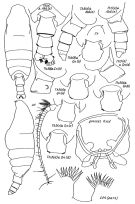 issued from : E.L. Markhaseva in Proc. Zool. Inst. RAN, St. Petersburg, 1996, 268. [p.291, Fig.233]. Female (from different specimens): Ce: forehead (lateral); CP4: coxopod of fourth legs (part.). (a): specimens from the Central part of Arctic Basin. (b-d): from different specimens. Nota: Cephalothorax 3.4-4.5 times longer than urosome. Posterior corners of last thoracic segment prolonged into asymmetrical lobes ending with small spines. Genital segment asymmetrical, widened more in its posterior half; projection on the right more developed than that on the left, varying in shape. A1 as long as cephalothorax, or reaching the midlength of urosome. Exopodite of P1 3-segmented, separation between segments 1 and 2 incomplete. Endopodite of P2 2-segmented. Coxopodite of P4 with 8-12 spines, weaker on the left leg than on the right.
|
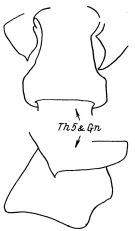 issued from : E.L. Markhaseva in Proc. Zool. Inst. RAN, St. Petersburg, 1996, 268. [p.293, Fig.235]. Female: distal part of metasome and genital segment (specimen in the Zoological Museum of Oslo University).
|
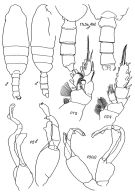 issued from : E.L. Markhaseva in Trudy Zool. Inst. RAN, St. Petersburg, 1996, 268. [p.292, Fig.234]. Female: P1, P2 (specimens from the central part of the Arctic Basin). Male (specimens from the Arctic Basin). Nota Male: Cephalothorax about 3 times longer than urosome. Cephalon and thoracic segment 1 fused, 4th and 5th thoracic segments fused. Posterior corners of last thoracic segment with small spine. A1 reaching the middle length of urosome. Oral parts reduced in comparison with those in females. Exopodite of P1 3-segmented; exopodal segment 1 with external spine shorter than in female. P5 powerful, configuration of segments changing in dependance of position of leg.
|
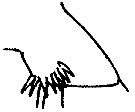 issued from : R.N. Wolfenden in Die Marinen Copepoden der Deutschen Südpolar-Expedition 1901-1903, 1911. [p.239, Fig.25]. As Euchirella elongata. Female: coxopodite of P4.
|
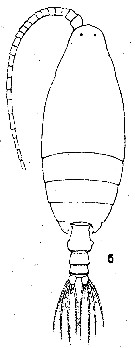 issued from : R.N. Wolfenden in Die Marinen Copepoden der Deutschen Südpolar-Expedition 1901-1903, 1911. [Pl.XXVIII, Fig.6]. As Euchirella elongata. Female: 6, habitus (dorsal).
|
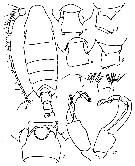 issued from : E.L. Markhaseva in Okeanol., 1984, 24 (3). [p.391, Fig.1]. As Pseudochirella elongata. Female (from 80°-86°N, 140-160°E): 1, habitus (dorsal); 2, forehead (lateral); 3-4, posterior part of prosome and genital segment (dorsal); 5-6, idem (left and rignt side, respectively); 7, idem (ventral); 8, A1; 9, basipod of P4. Male: 10, P5. 1-3, 5-9 after specimen from region of Franz Josef Land; 4, 10 after specimen from eastern part of Arctic Basin.
|
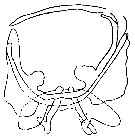 issued from : E.L. Markhaseva in Okeanol., 1984, 24 (3). [p.392, Fig.2]. As Pseudochirella elongata. Female (from Franz Josef Land): genital field (after KOH treatment).
|
 Issued from : E.L. Markhaseva in USSR Acad. Sci., Zool. Inst., Explor. Fauna Seas. Marine Plankton, 1989, 41 (49). [p.52, Fig.7]. Female: Thoracic segment 5 and genital segment. Nota from the key: 1 - Genital segment slightly asymmetrical. 2 - Right thoracic posterior corners with spine, left without spines. 3 - Genital segment on the right posteriorly with small and non bifid projection. Body length > 7 mm.
|
 Issued from : E.L. Markhaseva in USSR Acad. Sci., Zool. Inst., Explor. Fauna Seas. Marine Plankton, 1989, 41 (49). [p.53, Fig.18]. As Pseudochirella elongata. Female: Thoracic segment 5 and genital segment. Nota from the key: 1 - Genital segment asymmetrical. 2 - Right thoracic posterior corner with spine, non on left. 3 - Genital segment with backward right protuberance not divided.
|
 Pseudochirella spectabilis Pseudochirella spectabilis Male: 1 - Posterior corners of thoracic segment 5 rounded without spines, with small teeth on the left and right. 2 - Posterior corners of last thoracic segment with minuscule teeth on the right and left.
| | | | | Compl. Ref.: | | | Harding, 1966 (p.17, 71); Dunbar & Harding, 1968 (p.319); Vinogradov, 1968 (1970) (p.266); Minoda, 1971 (p.25); Kosobokova & al., 1998 (tab.2); Auel, 1999 (tab.2); Razouls & al., 2000 (p.343, tab. 4, 5, Appendix); Kosobokova & Hirche, 2000 (p.2029, tab.2); Yamaguchi & al., 2002 (p.1007, tab.1); Park & Ferrari, 2009 (p.143, Table 4, 6: bipolar distribution, Appendix 1, biogeography, Rem. p.167); Kosobokova & Hopcroft, 2010 (p.96, Table 1, fig.7); Kosobokova & al., 2011 (p.29, Table 2, Rem.: Arctic Basins) | | | | NZ: | 6 | | |
|
Distribution map of Pseudochirella spectabilis by geographical zones
|
| | | | | | 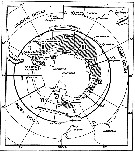 issued from : W. Vervoort in B.A.N.Z. Antarctic Reseach Expedition, Reports - Ser. B, Vol. III, 1957 [Fig.54]. As Pseudochirella elongata. issued from : W. Vervoort in B.A.N.Z. Antarctic Reseach Expedition, Reports - Ser. B, Vol. III, 1957 [Fig.54]. As Pseudochirella elongata.
Chart showing the geographical distribution (white circle) in the seas surrounding the Antarctic continent.
Nota: In this chart the area frequented by whaling vessels has been hatched. The Antarctic circle (66°.5 S) has been drawn as a broken line. The numbers I to VI refer to the sectors into which the Antarctic seas are divided according to Mackintosh (1942) (after Vervoort, 1951). |
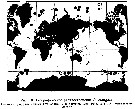 Issued from : E.L. Markhaseva in Issled. Fauny Morei, 1989, 41 (49). [p.56, Fig.12]. Issued from : E.L. Markhaseva in Issled. Fauny Morei, 1989, 41 (49). [p.56, Fig.12].
Geographical distribution of P. elongata (= P. spectabilis.
1: from literature as P. elongata; 2: present occurrences. |
| | | | Loc: | | | Antarctic (Weddell Sea, SW & SE Atlant., Indian, S, SW & SE Pacif.), Arctic ( polar Basin, Fletcher's Ice Is., Lomonosov Ridge, Nansen Basin, Amundsen Basin, Makarov Basin, Canada Basin), Greenland Sea, Bermuda (in Wilson, 1936 c), Bering Sea, Chile
Type locality: Arctic Basin (central part, off 84°N)
Markhaseva (1996, p.290) samples this species in epipelagial of the Arctic Basin under the temperature 1.6°C. | | | | N: | 26 | | | | Lg.: | | | (10) F: 7,7-7,5; (20) F: 7,75-7,16; M: 6,66; (25) F: 7,65; (37) F: 8-7,17; M: 6,66-6; (134) F: 8; M: 6; (208) F: 7,9; {F: 7,16-8,00; M: 6,00-6,66} | | | | Rem.: | epi-meso-bathypelagic.
Sampling depth (Antarct.) : 0-1000-5000 m.
This form seems typically bipolar.
All authors are not in accordance on the synonymy between P. spectabilis and P. elongata. For Park (1978, p.161) in the habitus of the female and the shape of the male P5, P. elongata is closely related to P. spectabilis, although they are distinct in anatomical details. In P. elongata the female can be readily recognized by the asymmetrically pointed posterolateral corners of the metasome and the characteristic shape of the genital segment in dorsal view. The male of P. elongata described for the first time, is distinct from the males of other species in the stucture of P5; that is, the exopods and endopods of both legs have large tubercles or processes, and the distal two segments of the left exopod are elongated, each bearing a large conical process distally.
After Markhaseva (1996, p.289) the two species P. elongata and P. spectabilis are synonyms. This author notes that Sars (1900) never recorded the asymmetry of posterior corners of last thoracic segment and genital segment; however, the stydied type specimen of Undeuchaeta spectabilis Sars, 1900 (deposited in the Zoological Museum of Oslo University) possesses genital segment and last thoracic segment asymmetrical and identical in structure to that in P. elongata (Wolfenden, 1905). | | | Last update : 30/01/2015 | |
|
|
 Any use of this site for a publication will be mentioned with the following reference : Any use of this site for a publication will be mentioned with the following reference :
Razouls C., Desreumaux N., Kouwenberg J. and de Bovée F., 2005-2025. - Biodiversity of Marine Planktonic Copepods (morphology, geographical distribution and biological data). Sorbonne University, CNRS. Available at http://copepodes.obs-banyuls.fr/en [Accessed June 04, 2025] © copyright 2005-2025 Sorbonne University, CNRS
|
|
 |
 |
















